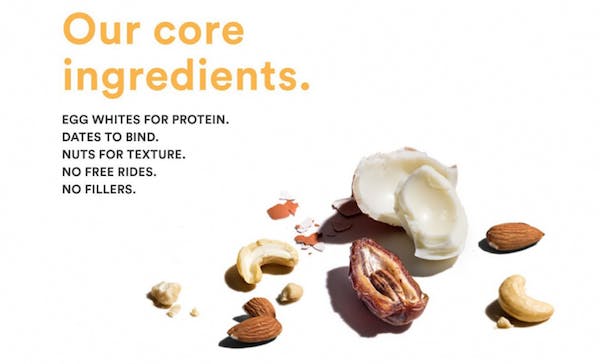People eat with their eyes, or so the expression goes, which is why food brands tend to rely on high quality imagery and design to sell their products.
But while words are tricky to get right, copywriting can be just as important from a marketing context, with the most successful examples triggering both an emotional response and a physical craving.
The trend for an artisanal tone of voice seems to have died down in the past few years (perhaps due to consumer frustration over patronising copy). In its place, a more upfront and creative approach has come to the forefront. Here are just a few of my favourite examples.
RX Bar
Continuing the theme of upfront marketing is RX Bar and its concise product copywriting. Taking the concept of ‘it does what it says on the tin’ to another level, the brand lists each product’s ingredients on the front in bold typeface.
As well as conveying a sense of honesty, it is the simplicity of the copywriting that really makes it effective. This also goes against competitor brands in the same space, who typically list countless (and hard to understand) ingredients on the back.
It’s also a trend within the health food industry to use marketing jargon to attempt to sell motivation (or a specific kind of lifestyle) rather than food. In contrast to this, RX Bar gives its audience credit, only selling them the product itself (not the false hope that it will help them reach fitness goals, or give them a new body).

Ben & Jerry’s
Food can be subjective, which makes taste rather difficult to describe. Over-emphasising flavours and ingredients can also leave consumers feeling overwhelmed, which is why I particularly like Ben & Jerry’s creative approach.
Everyone knows what mint choc chip ice cream tastes like, but the brand uses a personal tone to evoke the experience of actually eating it, which in turn makes it sound all the more enticing.
“This cool concoction packs quite the peppermint punch…but what you’ve really gotta watch out for are those gooey, chocolatey, fudgey brownies nestled in the tub.”
Ben & Jerry’s continues this approach with its recent ‘moophoria’ range, which has fewer calories than its regular products. Instead of focusing on what’s been left out, however, the brand emphasises the flavours of the ice cream first and foremost, with the fact that it is healthier coming second.

Ugly Drinks
Certain brands within the FMCG industry have been exposed as being economical with the truth; marketing themselves as ‘healthy’ when their products still contain more than the recommended amount of sugar, or other unhealthy ingredients.

Ugly Drinks aims to counteract this trend with its upfront and honest marketing. It uses copywriting to convey the fact that its product – a sparkling water drink with no artificial ingredients or sweeteners – isn’t pretending to be something it is not.
The brand is deliberately bold and to the point, telling consumers exactly what they can expect from the product. Using the concept of ‘ugly’ (as in the ugly truth), it is almost provocative, suggesting that consumers that they can look elsewhere if they don’t like it.
Its tone does not alienate, however, and instead helps to reassure consumers that they are not being mislead. In what can be a sickly sweet soft drinks market, Ugly Drinks makes a refreshing change.

Beyond Meat
According to research by WRI, the term ‘meat free’ can have negative connotations for consumers. This is mainly because it suggests that there is something lacking, as opposed to the product being appealing in its own right.
Beyond Meat is a brand that recognises this, and uses copywriting to counteract any sneering against vegan or plant-based foods. So, instead of avoiding any association with meat, it uses similar words and phrases that you’d see on a regular meat-based product.
Words like ‘sizzle’ and ’juicy’ are peppered in with phrases like ‘meaty texture’ and ‘satisfies like beef’. Another clever element is its tagline: “find it in the meat aisle”, which aims to instil the belief in consumers that the product is just as satisfying as regular meat.

There is the danger that this copywriting strategy could alienate staunch vegans, or people that do not want their plant-based products to taste like meat. However, with vegan now a mainstream choice for many, brands like Beyond Meat are finding ways to attract and engage former or current meat-eaters. In this case, it’s convincing copy.








